The NVIDIA GeForce GTX 750 Ti and GTX 750 Review: Maxwell Makes Its Move
by Ryan Smith & Ganesh T S on February 18, 2014 9:00 AM ESTOverclocking: When Headroom Exceeds Clockspeed Limits
Last but not least we have our customary look at overclocking performance. With all 3 of our cards being based on the same reference design, we expect to see some relatively consistent results between the cards. At the same time NVIDIA has told us that GTX 750 has some very interesting overclocking properties, and boy they weren’t kidding.
On a quick note, as a GPU Boost 2.0 product, overclocking on the GTX 750 series is not any different than on other GTX 700 series cards. It’s still based on offset overclocking, with the user adjusting offsets for the final overclock. But with that said there are two things to point out. The first is that the power target is limited to 100% on all cards. Because these are sub-75W cards, NVIDIA is not allowing anyone to exceed the card’s default TDP, so you only have as much power to play with as you started with. Second of all, none of our cards had available overvoltage bins. Apparently some cards do, but ours did not, so our voltage bins maxed out at the default bins you see listed.
Finally, all 3 cards have a maximum clock offset of 135MHz. This will be an important fact in a little bit.
| GeForce GTX 750 Series Overclocking | |||||
| GTX 750 Ti (Ref) | Zotac GTX 750 Ti | Zotac GTX 750 | |||
| Shipping Core Clock | 1020MHz | 1033MHz | 1033MHz | ||
| Shipping Max Boost Clock | 1150MHz | 1175MHz | 1163MHz | ||
| Shipping Memory Clock | 5.4GHz | 5.4GHz | 5.0GHz | ||
| Shipping Max Boost Voltage | 1.168v | 1.137v | 1.187v | ||
| Overclock Core Clock | 1155MHz | 1168MHz | 1168MHz | ||
| Overclock Max Boost Clock | 1285MHz | 1310MHz | 1298MHz | ||
| Overclock Memory Clock | 6.3GHz | 6.1GHz | 6.0GHz | ||
| Overclock Max Boost Voltage | 1.168v | 1.137v | 1.187v | ||
As we can quickly see, two patterns emerge. The first is that with every card equipped with 6GHz memory (though we remain unsure which mode the Zotac GTX 750’s is in), each and every card hits at least 6GHz, and sometimes a bit more. With the 128-bit memory bus generally providing the biggest bottleneck for GM107, the fact that there is 12%+ overclocking headroom here is going to be very helpful in feeding the tiny beast that is GM107.
More significantly however is the core overclock. We maxed out every single one. Every card, from the NVIDIA reference card to the Zotac cards, had no trouble overclocking by the full 135MHz to their respective maximum overclocks. The Zotac GTX 750 Ti, having the highest maximum boost clock by default, is technically the winner here at 1310MHz. But at this point everyone is a winner. Going by the maximum boost clock, every card is capable of an 11% core overclock, to go with that tasty 12% memory overclock.
The fact of the matter is that this is not something we normally encounter. Sub-75W cards are not poor overclockers, but they’re not usually strong overclockers either, which is why a 135MHz offset limit makes sense at first glance. But it’s clear that NVIDIA underestimated their own overclocking potential here when setting the specifications for these cards, as there’s seeming some headroom left untapped. Without additional offset room it’s impossible to say just how much more overclocking headroom remains – it may not be very much – but there should be room for at least some additional overclocking.
At this point with cards already in the pipeline we’ll have to take a look at individual cards and see what manufacturers have set their offset limits at. If they have followed NVIDIA’s specifications, then they’ll be equally limited. But hopefully with the launch now behind them, NVIDIA’s partners can work with NVIDIA on making greater offsets available on newer batches of cards.
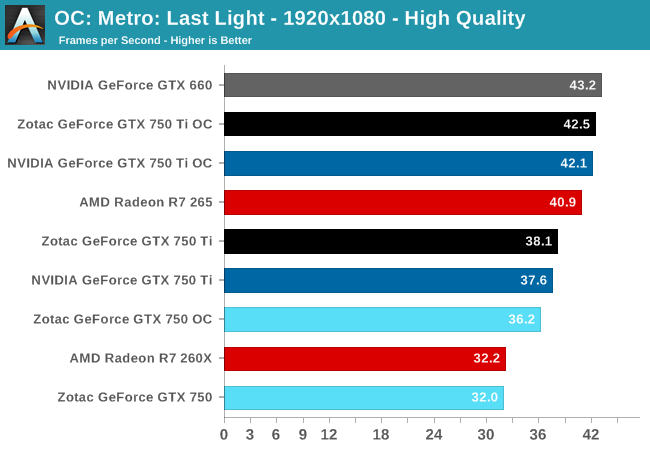
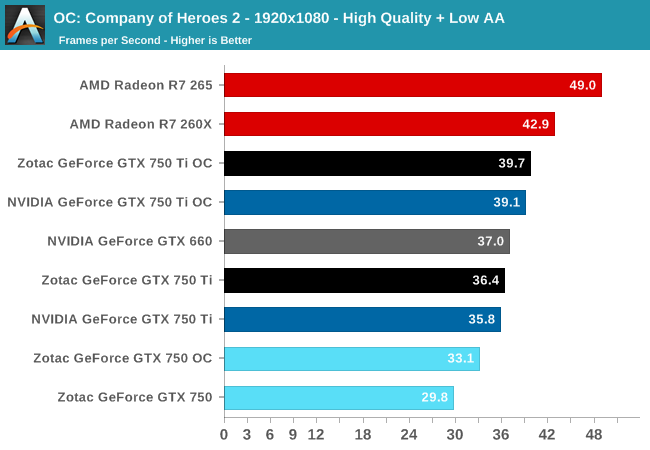
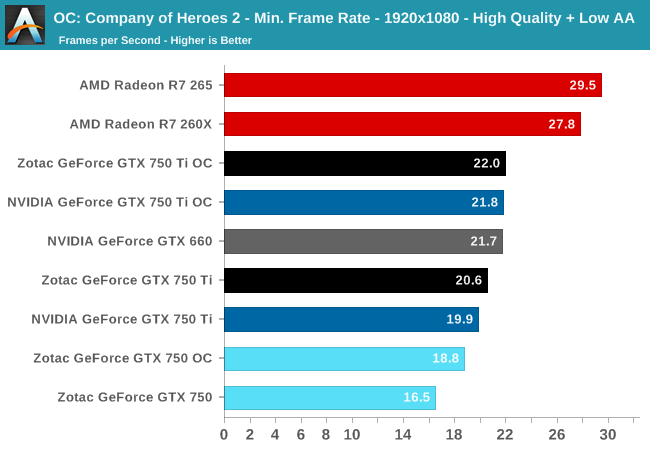

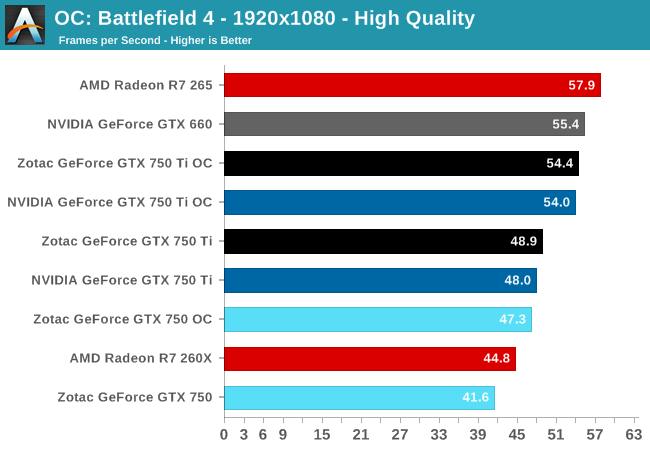
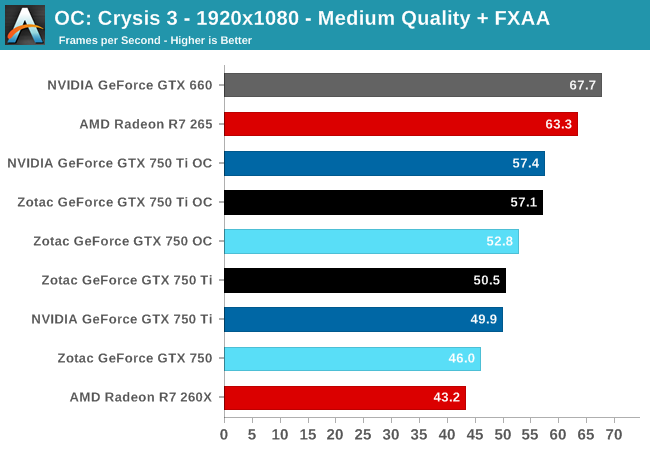
Depending on the game being used, the benefits from overclocking range from 9% to 12%, roughly in-line with our overclocks. For the GTX 750 this is sometimes enough to catch the stock clocked R7 260X, but even with this overclock the GTX 750 Ti will still generally trail the R7 265.
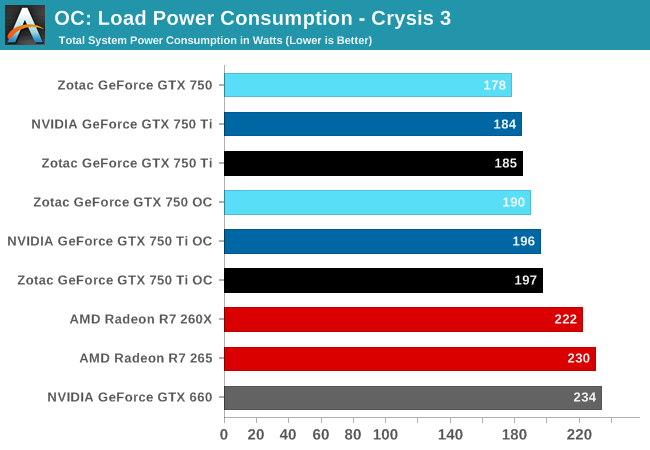

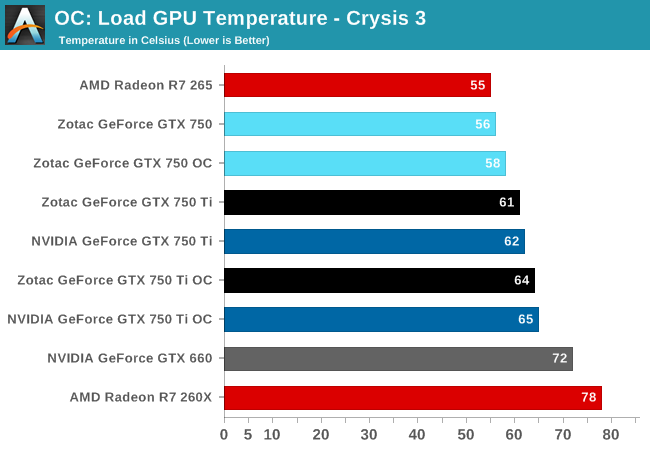
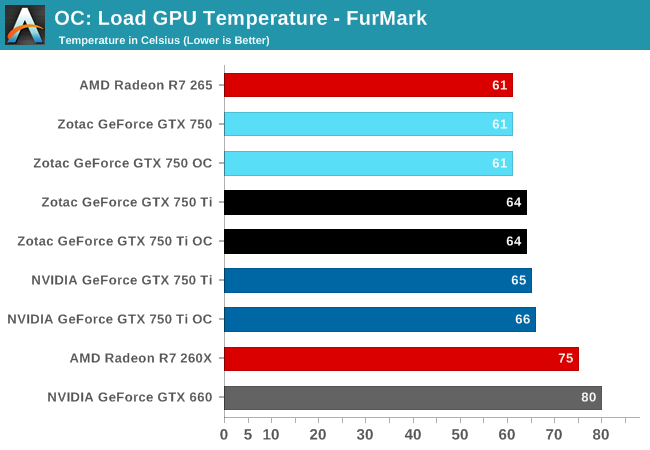
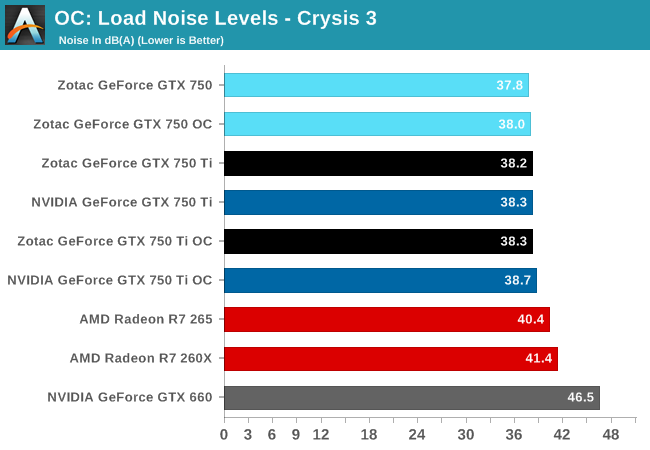
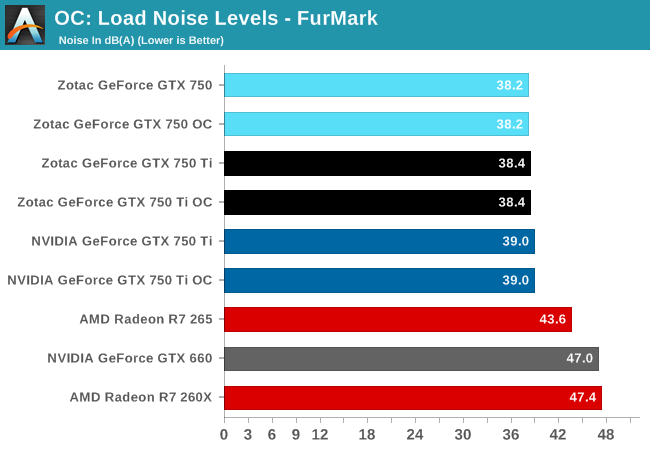
On the other hand, because of the hard TDP limit of 100%, this extra performance is relatively cheap. Video card power consumption moves by only a few watts, and then a few watts of CPU time on top of that. For all practical purposes overclocking can extend NVIDIA’s already incredible performance-per-watt ratio by another 10% with no meaningful impact on noise. Given the consistency of overclocking headroom we’ve seen in our GTX 750 series samples, this is one of those scenarios where overclocking is going to be a reasonable and (relatively) fool proof action to take.










177 Comments
View All Comments
dylan522p - Tuesday, February 18, 2014 - link
They are waiting for 20nm for the entire 800 series .MugatoPdub - Tuesday, February 18, 2014 - link
Interestingly, it seems Nvidia has simply followed Intel in the "mobile first" market race, it is starting to feel as if the enthusiast will be left in the dust within the next few years =(Krysto - Tuesday, February 18, 2014 - link
Not likely, thanks to the boom in VR that we'll be seeing, which at 4k and 120fps games, will require 16x the performance we get now for games, just to play the same games, in a few years.So if anything, Nvidia should be making GPU's at the high-end that are a level or two ABOVE Titan (think 20-30 TF GPUs in 2015).
A5 - Tuesday, February 18, 2014 - link
They probably will? I'm guessing we won't see stuff below the top end (or SLI) targeted at 4K until late 2015/spring 2016, though.madmilk - Tuesday, February 18, 2014 - link
I doubt enthusiasts will be left behind, simply because HPC users will demand a 225W Tesla card. That in turn can easily sold as a 250W enthusiast card, perhaps under the Titan line.Mondozai - Wednesday, February 19, 2014 - link
Also, Nvidias desktop business is contributing to their profits and is seeing revenue growth. Their Tegra business revenue is falling almost 50% year over year.The desktop high-end GPU market will grow in good health for years to come. Their discrete laptop GPUs, however, will face doom in a relativeley short period of time as integrated GPUs performance rises to a level when most people are satisfied. Laptops specifically for gaming continues to be an unsignificant market.
jkauff - Tuesday, February 18, 2014 - link
madVR NNEDI3 uses OpenCL, and works fine on Intel and AMD boards. NVIDIA OpenCL support has been broken for the last couple of driver iterations. Please use your influence with the NVIDIA developers to get this fixed in the next driver release.IKeelU - Tuesday, February 18, 2014 - link
ugh, cryptocointexasti89 - Tuesday, February 18, 2014 - link
Wow! .. Substantially faster than 260x and consuming less than 60w using same process node. Really impressive. I can't wait to see how Maxwell arch performance & power scale at 20nm. I'm really convinced now that AMD GCN is not as efficient as many reviewers think. AMD will very likely have a hard time in this round.g101 - Tuesday, February 18, 2014 - link
*slower...Almost always slower than the 260x.... , all for power savings in the range of 5-10%...How...exciting?You should try reading the actual words that have been written in the article.